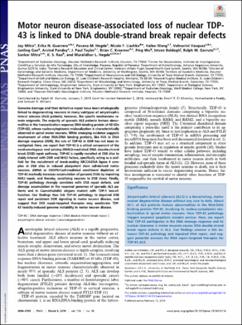Motor neuron disease-associated loss of nuclear TDP-43 is linked to DNA double-strand break repair defects

View/
Date
2019-03-05Author
Mitra, Joy
Guerrero, Erika N
Hegde, Pavana M
Liachko, Nicole F
Wang, Haibo
Vasquez, Velmarini
Gao, Junling
Pandey, Arvind
Taylor, J Paul
Kraemer, Brian C
Wu, Ping
Boldogh, Istvan
Garruto, Ralph M
Mitra, Sankar
Rao, KS Jagannatha
Hegde, Muralidhar L
Metadata
Show full item recordAbstract
Genome damage and their defective repair have been etiologically linked to degenerating neurons in many subtypes of amyotrophic lateral sclerosis (ALS) patients; however, the specific mechanisms remain enigmatic. The majority of sporadic ALS patients feature abnormalities in the transactivation response DNA-binding protein of 43 kDa (TDP-43), whose nucleo-cytoplasmic mislocalization is characteristically observed in spinal motor neurons. While emerging evidence suggests involvement of other RNA/DNA binding proteins, like FUS in DNA damage response (DDR), the role of TDP-43 in DDR has not been investigated. Here, we report that TDP-43 is a critical component of the nonhomologous end joining (NHEJ)-mediated DNA double-strand break (DSB) repair pathway. TDP-43 is rapidly recruited at DSB sites to stably interact with DDR and NHEJ factors, specifically acting as a scaffold for the recruitment of break-sealing XRCC4-DNA ligase 4 complex at DSB sites in induced pluripotent stem cell-derived motor neurons. shRNA or CRISPR/Cas9-mediated conditional depletion of TDP-43 markedly increases accumulation of genomic DSBs by impairing NHEJ repair, and thereby, sensitizing neurons to DSB stress. Finally, TDP-43 pathology strongly correlates with DSB repair defects, and damage accumulation in the neuronal genomes of sporadic ALS patients and in Caenorhabditis elegans mutant with TDP-1 loss-of-function. Our findings thus link TDP-43 pathology to impaired DSB repair and persistent DDR signaling in motor neuron disease, and suggest that DSB repair-targeted therapies may ameliorate TDP-43 toxicity-induced genome instability in motor neuron disease.
